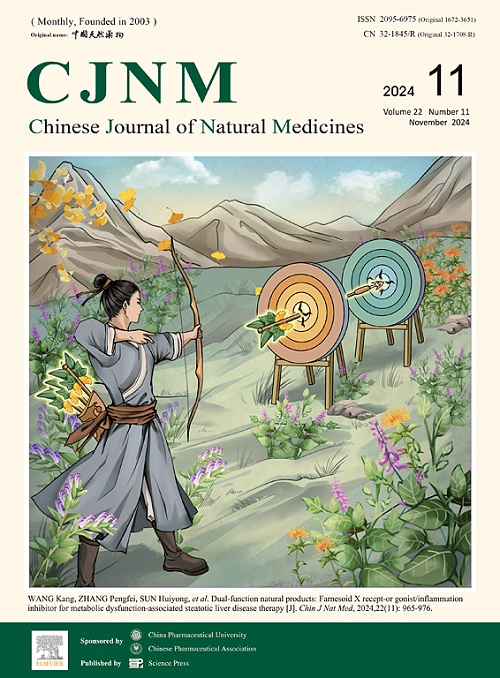Bioactivity-guided discovery of antiviral templichalasins A‒C from the endophytic fungus Aspergillus templicola
IF 4.9
2区 医学
Q1 INTEGRATIVE & COMPLEMENTARY MEDICINE
引用次数: 0
Abstract
The bioactivity-guided isolation of potentially active natural products has been widely utilized in pharmaceutical discovery. In this study, by screening fungal extracts against coxsackievirus B3 (CVB3), three new aspochalasins, templichalasins A‒C (1‒3), along with six known aspochalasins (4‒9) were isolated from an active extract derived from the endophytic fungus Aspergillus templicola LHWf045. Compound 1 features a unique 5/6/5/7/5 pentacyclic ring system, while compounds 2 and 3 possess unusual 5/6/6/7 tetracyclic skeletons. Their structures were characterized through extensive spectroscopic analyses, electronic circular dichroism (ECD) calculations, and single-crystal X-ray diffraction analysis. Additionally, we demonstrated that compound 4 can be readily converted into compounds 1‒3 under mild acidic conditions and proposed a plausible mechanism for this conversion. Bioactivity evaluation of compounds 1‒9 against CVB3 revealed the inhibitory effects of all compounds against the virus. Notably, compound 9 exhibited superior antiviral activity, surpassing the commercial drug ribavirin in selectivity index (SI) value.
从内生真菌templicola Aspergillus templichalasins A-C中生物活性导向的抗病毒药物的发现
生物活性引导分离潜在活性天然产物已广泛应用于药物发现。在本研究中,通过筛选抗柯萨奇病毒B3 (CVB3)的真菌提取物,从内生真菌Aspergillus templicola LHWf045的活性提取物中分离到3个新的aspochalasins, templichalasins A-C(1-3)和6个已知的aspochalasins(4-9)。化合物1具有独特的5/6/5/7/5五环体系,而化合物2和3具有不寻常的5/6/6/7四环骨架。通过广泛的光谱分析、电子圆二色性(ECD)计算和单晶x射线衍射分析对其结构进行了表征。此外,我们证明了化合物4在温和的酸性条件下可以很容易地转化为化合物1-3,并提出了这种转化的合理机制。化合物1 ~ 9对CVB3的生物活性评价表明,所有化合物对病毒均有抑制作用。值得注意的是,化合物9表现出优异的抗病毒活性,其选择性指数(SI)值超过了市售药物利巴韦林。
本文章由计算机程序翻译,如有差异,请以英文原文为准。
求助全文
约1分钟内获得全文
求助全文
来源期刊

Chinese Journal of Natural Medicines
INTEGRATIVE & COMPLEMENTARY MEDICINE-PHARMACOLOGY & PHARMACY
CiteScore
7.50
自引率
4.30%
发文量
2235
期刊介绍:
The Chinese Journal of Natural Medicines (CJNM), founded and sponsored in May 2003 by China Pharmaceutical University and the Chinese Pharmaceutical Association, is devoted to communication among pharmaceutical and medical scientists interested in the advancement of Traditional Chinese Medicines (TCM). CJNM publishes articles relating to a broad spectrum of bioactive natural products, leading compounds and medicines derived from Traditional Chinese Medicines (TCM).
Topics covered by the journal are: Resources of Traditional Chinese Medicines; Interaction and complexity of prescription; Natural Products Chemistry (including structure modification, semi-and total synthesis, bio-transformation); Pharmacology of natural products and prescription (including pharmacokinetics and toxicology); Pharmaceutics and Analytical Methods of natural products.
 求助内容:
求助内容: 应助结果提醒方式:
应助结果提醒方式:


